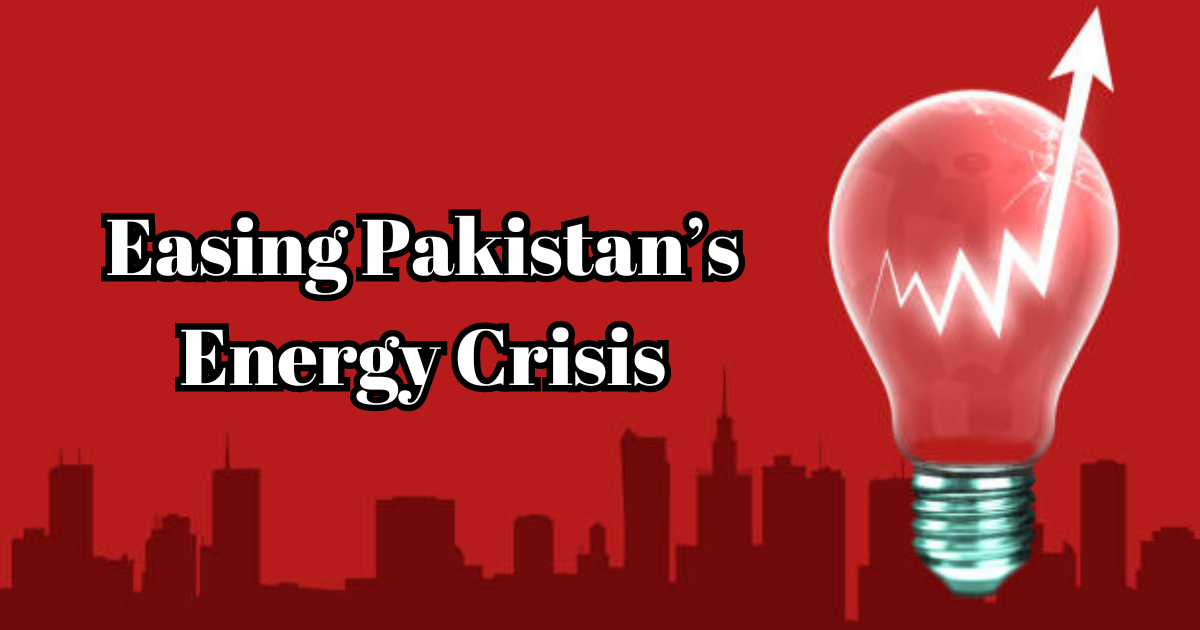
Easing Pakistan Energy Crisis
Pakistan has 4,500–5,000 MW of energy shortages (but in recent years, these shortages have occasionally surged to 8,500 MW—more than 40% of the country’s demand). (OGDCL) projects that Pakistan’s domestic natural gas supplies would run out by 2030 and that the country’s oil reserves will run out by 2025 due to increased oil and gas consumption.
However, it is arguable that Pakistan’s energy issues stem more from a lack of governance than from a lack of actual supply. The energy industry is plagued by pervasive inefficiencies, including losses in transmission and distribution (T&D) exceeding twenty percent, in addition to multibillion-dollar debt.
Poor maintenance, malfunctioning equipment, and energy theft are the causes of the losses. The debt, which is frequently referred to as “circular,” results from issues with cash flow. Funds are lacking for energy producers, distributors, and transmitters. Part of the reason for this is a bad pricing strategy: the Pakistani government charges extremely little for energy, yet very few consumers pay their bills. Revenue is therefore low, and the industry cannot pay for the provision of electricity.
Concerning ramifications of Pakistan’s energy dilemma are its fragile economy and unstable security environment. The nation has suffered losses from power shortages in recent years of up to 4% of GDP. Numerous factories have been forced to close, with over 500 of them in the industrial centre of Faisalabad alone.
Pakistan’s creditworthiness will suffer as a result of electricity shortages, according to Moody’s ratings company.

Pakistan is experiencing a serious energy crisis that is typified by an increasing electricity deficit that has reached 7,000 megawatts. The extreme heatwaves have made the energy shortfall worse, which has raised demand. At the moment, independent power producers (IPPs) generate 9,677 megawatts, thermal power plants provide 1,060 megawatts, and hydropower generates 4,635 megawatts. Numerous power facilities had to close due to shortages of coal, gas and oil, which caused severe load shedding that lasted for 10 to 12 hours in various sections of the nation.
Although the government has made several efforts to lessen the circular debt, it still poses a significant issue. Circular debt has risen from Rs 160 billion in 2008 to Rs 2,377 billion in 2023, indicating a worsening rather than improving state of affairs. The Human Rights Watch Report states that the IMF and the Pakistani government should conduct a comprehensive assessment of the adjustment consequences.
The Economic Survey of Pakistan estimates that in 2021, Pakistan’s fiscal deficit will be Rs. 1.13 trillion. Owing to the significant budget deficit, new electricity projects cannot be started without a set amount of funding.
Each year, 100 billion invoices are unpaid and 4,500 megawatts of electricity are stolen. The economy suffers from this practice. If energy is stolen and unpaid debts arise, the nation will not be able to afford energy given its spiralling mounting debt. In 2021, there was a 2.73 trillion energy theft reported.
Causes of Pakistan Energy Crisis
- Unaffordable Energy Mix: In 1984, about 60 % energy needs of the country were fulfilled from hydel resources. However, it dropped to 30% in less than 3 decades and currently the major portion of the country’s energy mix is coming from expensive imported oil and LNG. At present, Pakistan produces almost 80% of its electricity from crude oil, 11% from hydel, 6% from coal, 1% from LPG and 2% from nuclear energy. In this regard, the higher oil prices in the global market and the massive depreciation of the Pakistani rupee are making oil more expensive, triggering external sector pressure and widening the trade deficit of the country.
- Lack of Investment in Energy Sector: Pakistan’s energy crisis is exacerbated by inadequate investment in the sector. The country has failed to make substantial investments in building new power plants or upgrading existing infrastructure to meet the growing energy demand. The consequence is a widening gap between energy supply and demand, leading to frequent power outages. According to the Economic Survey of Pakistan 2022-23, the energy mix consists of 58.8 percent thermal, 25.8 percent hydel, and 8.6 percent nuclear power, with only 6.8 percent from alternative sources. This lack of diversification hampers the resilience of the energy sector, contributing to the ongoing crisis.
- Circular Debt Issue: The circular debt problem in Pakistan’s energy sector exacerbates the crisis. Circular debt occurs when power generation companies are not paid on time by the government or consumers. As a result, there’s a shortage of funds for fuel and maintenance, disrupting the energy generation process. The circular debt was Rs 2467 billion by March 2022, equating to 3.8 percent of Pakistan’s GDP and representing 5.6 percent of the government debt. This persistent issue adds financial strain to the energy sector and impedes its ability to function optimally.
- Over-reliance on Fossil Fuels: Pakistan’s energy mix heavily leans on finite and expensive resources, particularly natural gas and oil. This over-reliance makes the energy sector vulnerable to price fluctuations and supply disruptions. In 2023, about 80 percent of Pakistan’s electricity was produced from crude oil, contributing to external sector pressure due to the higher oil prices in the global market. The depletion of indigenous natural gas reserves has forced the country to import expensive liquefied natural gas (LNG), straining its foreign exchange reserves.
- Inefficient Energy Use: Wasteful energy consumption practices in industrial, commercial, and residential sectors contribute significantly to the crisis. The lack of energy-efficient technologies and conservation measures results in higher energy demand. This inefficiency is a key factor in the widening electricity shortfall, reaching 7,000 megawatts during the summer months of 2023. Implementing energy-saving technologies and promoting conservation measures could mitigate the impact of the crisis.
- Political Interference: Frequent political interference in the energy sector has led to inefficiencies, mismanagement, and a lack of transparency. The absence of a stable, long-term energy policy due to political inconsistencies has deterred investments. For example, the construction of the Kalabagh dam, with an estimated capacity of 3600 MW, has been hindered by political protests and disagreements among provinces, highlighting the challenges arising from political interference in energy-related decisions.
- Poor Economic Growth: A weak and unstable economic system in Pakistan limits the government’s capacity to invest in the energy sector. Limited financial resources impede the development of new power projects, maintenance of existing infrastructure, and adoption of advanced technologies. Insufficient funds contribute to a shortage of electricity generation capacity, perpetuating the energy crisis. The economic challenges further discourage foreign investments and loans essential for energy sector development.
- Electricity Theft and Losses: Ongoing electricity theft is a potent factor behind the energy crisis, with significant financial implications. In the fiscal year 2022-2023, the country lost Rs 380 billion due to power theft, and this loss is estimated to reach Rs 520 billion the following year. The combination of unpaid bills, power theft, and circular debt creates a substantial financial burden on the energy sector and the country’s economy. Addressing this issue requires immediate action to curb theft and losses, along with strict measures to ensure accountability and payment of dues by consumers and employees alike.
Consequences of Energy Crisis:
- Economic Impacts: The energy crisis in Pakistan has severe consequences for the country’s economy. Power outages and an unreliable energy supply hamper industrial productivity, leading to economic losses. The acute energy crisis during the summer months of 2023, with a 7,000-megawatt shortfall, significantly disrupted economic activities. According to a report, the energy crisis has become a major obstacle to Pakistan’s economic growth and industrialization, hindering the nation’s ability to attract investments and stifling technological progress. The economic repercussions are multifaceted, affecting various sectors and hindering the overall development of the country.
- Disruption of Daily Life: Frequent power outages, a direct consequence of the energy crisis, disrupt daily life for millions of Pakistanis. The unreliability of electricity supply impacts households, businesses, and essential services. For example, the summer of 2023 witnessed a widening gap between electricity demand (28,200 megawatts) and supply (21,200 megawatts), leading to extended power cuts. This disruption not only affects domestic comfort but also puts a strain on businesses, particularly those dependent on continuous power, such as the manufacturing sector.
- Hindered Technological Progress: The energy deficit in Pakistan impedes technological progress and innovation. The lack of a consistent and reliable power supply hinders the operation of technology-dependent industries and discourages investment in technological advancements. In a rapidly evolving global landscape, technological stagnation due to energy shortages puts Pakistan at a disadvantage in terms of competitiveness and adaptability. The consequences extend beyond immediate economic setbacks to the nation’s long-term ability to keep pace with global technological advancements.
- Environmental Degradation: The over-reliance on fossil fuels, especially crude oil, exacerbates environmental degradation and contributes to climate change. The energy mix heavily skewed towards non-renewable resources results in increased carbon emissions. Imported liquefied natural gas (LNG) and oil contribute to the strain on foreign exchange reserves. The environmental consequences, including air pollution and greenhouse gas emissions, further underscore the urgent need for a shift to cleaner and more sustainable energy sources.
- Social Unrest: Persistent electricity shortages and the economic hardships resulting from the energy crisis contribute to social unrest. Protests and threats of business closures have become commonplace, reflecting the frustration of domestic consumers, manufacturers, traders, and small and medium-sized enterprises (SMEs). Social instability stemming from discontent over the energy situation poses a threat to the overall socio-political fabric of the country.
- Impaired Industrial Growth: The industrial sector bears a significant brunt of the energy crisis. Power shortages and high electricity costs undermine industrial growth and competitiveness. Industries face challenges in meeting production targets, leading to reduced exports and economic inefficiencies. The circular debt issue, reaching Rs 2467 billion, adds financial strain to the industrial sector, limiting its capacity to invest in modern technologies and expand operations.
- Foreign Investment Deterrence: The energy crisis acts as a deterrent to foreign investments in Pakistan. The unreliability of the energy supply and the associated economic uncertainties discourage foreign businesses from establishing or expanding operations in the country. This lack of foreign investment further exacerbates the economic challenges, hindering the nation’s ability to develop and modernize its energy infrastructure. The consequences of reduced foreign investment ripple across various sectors, impacting employment, economic growth, and the overall well-being of the population.
Recommendations to Solve Energy Crisis
- Embrace Renewable Energy Sources: To address Pakistan’s energy crisis, a fundamental recommendation is the widespread adoption of renewable energy sources. The Alternative and Renewable Energy (ARE) Policy 2020 aimed to increase the share of ARE in total power supply to 20% by 2025 and 30% by 2030. Solar, wind, hydroelectric, biomass, and geothermal energy offer sustainable alternatives. Pakistan’s abundant sunlight, wind corridors, and river systems present significant untapped potential. By harnessing these resources, Pakistan can reduce its dependence on finite and expensive fossil fuels, mitigating the impact of price fluctuations and supply disruptions.
- Overhaul Energy Sector Governance: Addressing the root causes of the energy crisis requires comprehensive reforms in the governance of the energy sector. The circular debt issue, reaching Rs 2467 billion, highlights the inefficiencies and mismanagement within the sector. Implementing transparent and accountable practices, reducing political interference, and ensuring timely payments to power generation companies are essential steps. Reforms should focus on creating a conducive environment for private investment, enhancing operational efficiency, and fostering a sustainable energy ecosystem.
- Diversify Energy Mix: A key recommendation is diversifying Pakistan’s energy mix to reduce vulnerability to supply disruptions and price fluctuations. The current energy mix is heavily skewed towards fossil fuels, with 80% of electricity production from crude oil. Shifting towards a more balanced mix that includes renewables, hydropower, and nuclear energy can enhance energy security. The estimated hydropower potential of Pakistan is about 60,000 MW, with only 16% currently utilized. Diversification offers a strategic approach to meet growing energy demands while minimizing environmental impact.
- Enhance Energy Efficiency: Improving energy efficiency is crucial to maximize the output from existing resources. Wasteful industrial, commercial, and residential energy consumption practices contribute to the crisis. Implementing energy-efficient technologies, conservation measures, and promoting responsible energy use can alleviate the strain on the energy supply. The lack of investment in upgrading existing infrastructure contributes to inefficiencies. By adopting modern technologies and practices, Pakistan can optimize its energy consumption and bridge the demand-supply gap.
- Implement Policy Reforms: The ARE Policy 2020 introduced competitive bidding for the lowest-cost power generation, providing incentives for technology transfer and setting clear targets for increasing the share of renewable energy. However, addressing the energy crisis requires continuous policy adjustments. Long-term targets, consistent regulatory frameworks, and policies addressing key barriers such as high technology costs and insufficient energy infrastructure are essential. A supportive policy environment is critical to encouraging private investment and fostering innovation in the alternative energy sector.
- Address Circular Debt: Tackling the circular debt issue is imperative for the sustainability of the energy sector. The circular debt, reaching Rs 2467 billion, results from delayed payments by the government and consumers to power generation companies. Implementing effective mechanisms to address circular debt, ensuring timely payments, and exploring financial restructuring options are essential. This will stabilize the financial health of the energy sector, providing a reliable foundation for future investments and operations.
- Invest in Infrastructure: Investing in resilient energy infrastructure is a prerequisite for overcoming the energy crisis. Expanding and upgrading power generation capacity, transmission and distribution networks, and fuel supply chains are critical components. The government should leverage advanced technologies to enhance the efficiency and reliability of the energy infrastructure. Furthermore, partnerships with private entities can facilitate risk-sharing, expertise-sharing, and attract necessary investments. A modern and resilient energy infrastructure will ensure a stable and uninterrupted power supply, fostering economic growth and stability.
Pakistan Energy Crisis; Causes, Consequences and Solutions
Admin at The Pakistan Gazette

